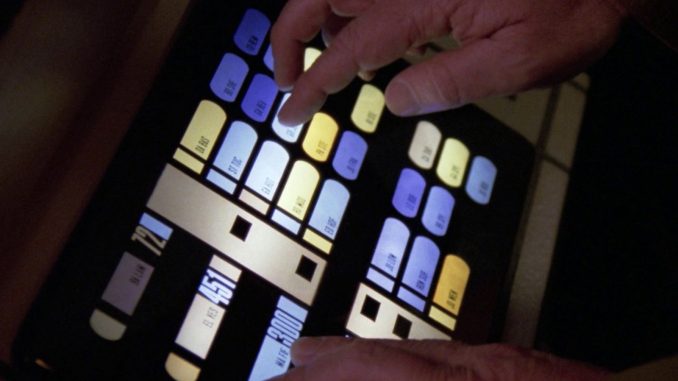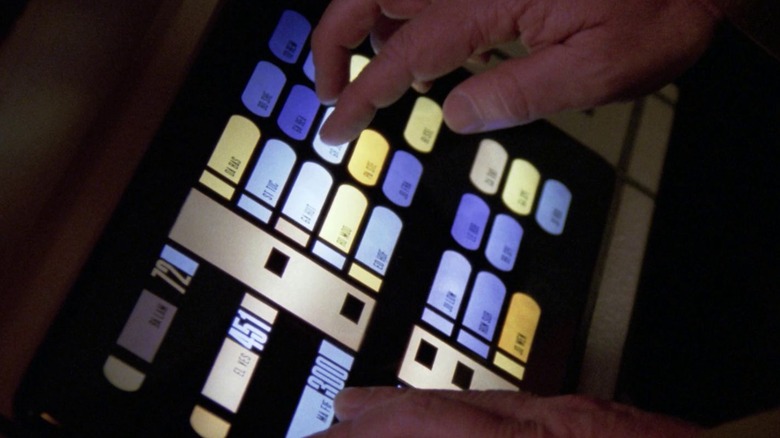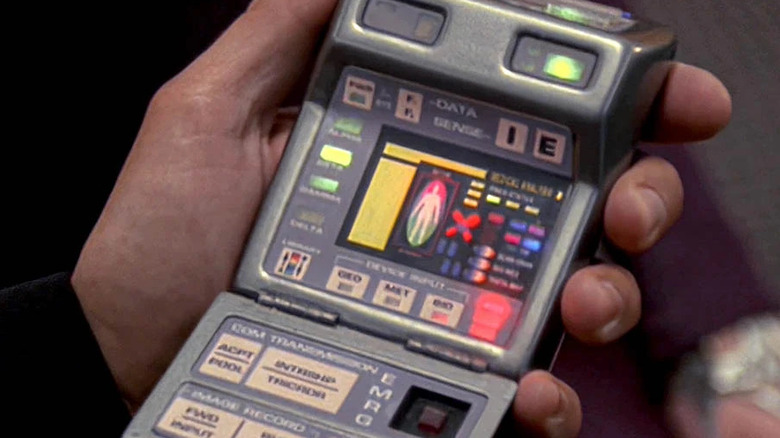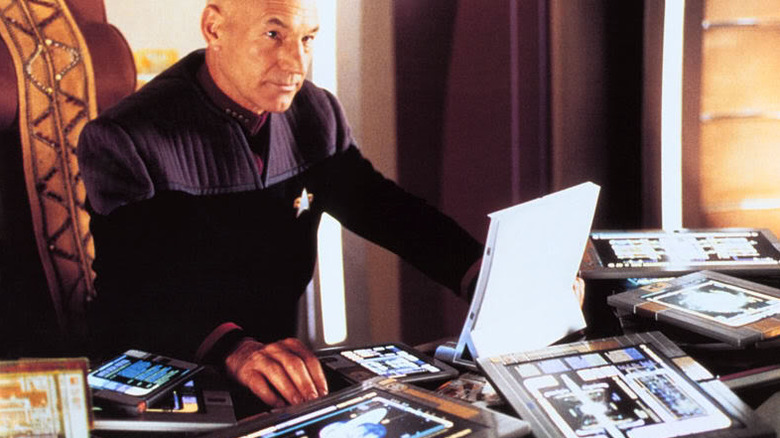
We may receive a commission on purchases made from links.
On the original “Star Trek,” the computers on the U.S.S. Enterprise were operated by a series of switches, dials, knobs, and buttons, many of them unlabeled. For the most part, the switches’ functions remained obscure to viewers. It seemed that a skilled Starfleet officer, while sitting on the bridge, would simply have to know which switches activated what system just to perform even the most basic tasks on board a starship. Perhaps attentive Trekkies may have been able to look closely at the “Star Trek” actors and discern what buttons they were pushing when Captain Kirk (William Shatner) gave an order to go to warp, but said actors may admit that they more or less pushed buttons at random.
On “Star Trek: The Next Generation,” the computer panels became far sleeker and more sophisticated. The knobs and dials were replaced by flat, glowing touch panels, each of them emblazoned by square “windows,” weirdly numbered subroutines, and dozens of oval-shaped buttons. Officers on board the Enterprise-D looked like typists, constantly inputting information into their personal touch panels.
Although never mentioned by name on “Next Generation,” the computer graphical interface was called LCARS. This term is taken from many, many extant expanded universe texts, most notably Rick Sternbach and Michael Okuda’s 1991 sourcebook “Star Trek: The Next Generation Technical Manual,” a must-own for deep-cut Trekkies. According to that book, LCARS stands for “Library Computer Access/Retrieval System.”
LCARS wasn’t an obscure detail. It was the basic design of all starships on “Star Trek” from 1987 through 2001 before later being brought back for some of the newer “Star Trek” shows in the ’20s.
LCARS, Okudagrams, and other fun nerdy details about Star Trek computers
There have been a few notable close-ups of the LCARS equipment throughout the “Star Trek” franchise, and one can see that a great deal of attention went into its design. LCARS was invented and designed by Michael Okuda, who followed a mandate from “Star Trek” creator Gene Roddenberry. The computers on “Next Generation” had to look more advanced than the ones on the original series, so Okuda (who’s been involved with multiple “Star Trek” projects, including “Star Trek VI: The Undiscovered Country”) invented the screen-based touch panels in response. The idea was to have a lot more visual activity on the Enterprise’s computer screens, implying that millions of actions needed to be taken daily just to keep the ship going.
Okuda’s designs extended to tricorders as well, and a few close-ups of the hand-held, flip-open scanners revealed that they, too, are complicated pieces of machinery and need a lot of adjustment to operate properly. One might also see the LCARS designs on a PADD (Personal Access Display Device), which is the “Star Trek” equivalent of a modern-day tablet. In 1987, a PADD was high-tech; in 2025, it’s in everyone’s living room. Okuda’s designs also made the computers on “Star Trek” look difficult and byzantine which, oddly, made them more realistic. It was nice to think that the computers on “Star Trek” were so unbearably sophisticated that one would require special training to operate them.
An even closer look at the LCARS panel might reveal that most of the buttons are marked with obscure five-letter codes, usually presented in a two-letter-space-three-letter configuration. Trekkies will be able to tell you that these five-letter codes are colloquially referred to as Okudagrams, while the letters are the initials of people on the “Star Trek” production team.
The continued used of LCARS throughout Star Trek
Paramount, of course, owns the rights to the LCARS design and has had to take legal action against individuals who design phone apps that’ve used an LCARS layout and color scheme. Some modern-day computer companies, however, have licensed the LCARS design, and Trekkies can now use PADDs pretty much in real life.
There have also been a few instances throughout the “Star Trek” franchise where it’s been implied that certain LCARS systems are operated on PADDs that produce tactile, “raised-button” systems, allowing them to be operated by visually impaired officers.
LCARS was in use with pretty much the same design throughout 1990s “Star Trek” shows and was redesigned a little bit for latter-day “Star Trek” movies. The warmer lavenders, golds, and beiges gave way to steelier blues and whites. The classic system was brought back for “Star Trek: Lower Decks” in 2020 (“Lower Decks” is set only a few years after the end of “Next Generation”). In the timeline of “Star Trek: Picard,” a series set several decades after “Next Generation,” LCARS had partially moved from PADDs and panels to hovering, translucent holographic displays. Those kinds of displays, however, were usually only seen in conference rooms or in people’s homes. For the most part, touchscreen LCARS panels remained in place as the standard on starship workstations.
In the early days of “Next Generation,” the LCARS displays were lit by rotating light fixtures and didn’t have a lot of notable graphics, which would have been difficult to achieve in 1987. It wasn’t until much later that production staff would install the “Star Trek” sets with actual TV screens.




Leave a Reply